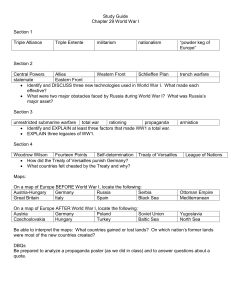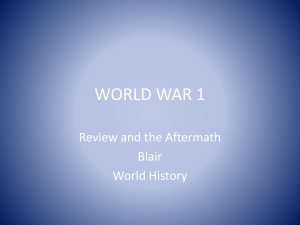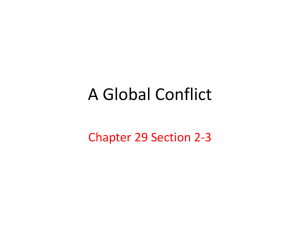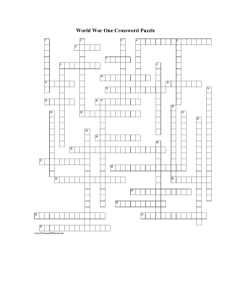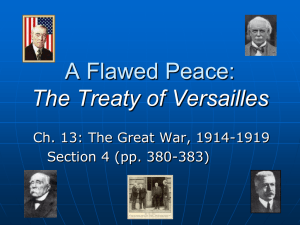The Spark - Beginning of World War One *
advertisement
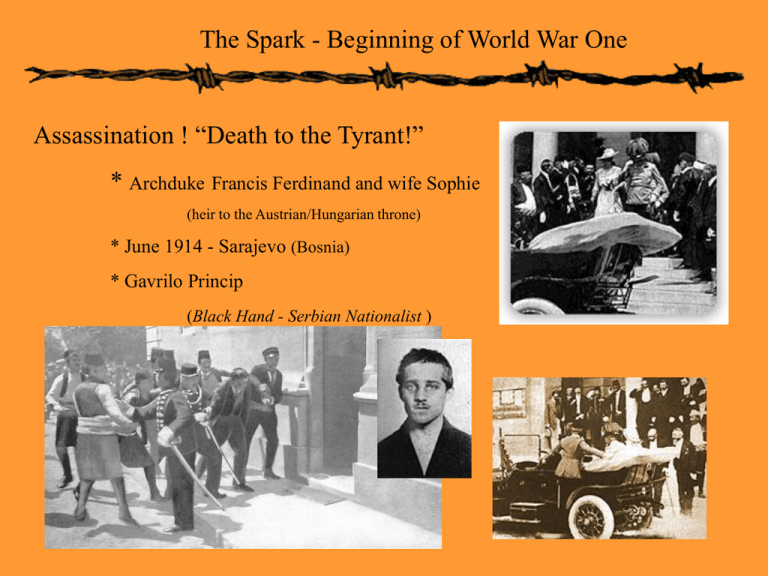
The Spark - Beginning of World War One Assassination ! “Death to the Tyrant!” * Archduke Francis Ferdinand and wife Sophie (heir to the Austrian/Hungarian throne) * June 1914 - Sarajevo (Bosnia) * Gavrilo Princip (Black Hand - Serbian Nationalist ) Declaration of War - Beginning of World War One Austrian Ultimatum –Check w/Germany first to see if they have back up. * Serbian appeal for Russian help. Slavic support * Russian Mobilization Germany demand to cease. Reason? * Declaration of War - August 1914 Germany - Wilhelm II Serbia - King Peter (Slavic) Russia - Nicholas II (Slavic) Austria - Franz Joseph Background - Beginning of World War One * Inquiry - Review the locations of nations belonging to the Triple Alliance and Triple Entente. What problem did Germany face if war broke out in 1914? * Define: Mobilization/Standing Army The Schlieflen Plan - Beginning of World War One * War Strategy of General Alfred Von Schllieffen: - Invade France through neutral Belgium (This brings in Britain, Belgium is an ally) - Defeat France within 6 weeks – before the time needed for Russia to mobilization. - Transport Western Front forces to east and defeat Russia. Sides/Fronts - Beginning of World War One Allied Powers (Entente) * France, Great Britain, Russia, Italy Central Powers (Triple All.) * Germany, Austria/Hungary, Bulgaria, Ottoman Empire Fronts - Western/Eastern * First Battle of the Marne (Western) Stalemate * Difference between fronts Trench Warfare Trench Warfare • Machine gun and artillery made remaining on surface impossible • Each side created huge networks of trenches, easy to defend, very difficult to take. • Life in the trenches: – – – – Poor food and medical care Little sleep Trenchfoot Cold Russian Soldier War in the Industrial Age • Industrialization allowed better farming techniques– population boom • Industrialization allowed nations to organize, train, and equip millions of men • Industrialization allowed nations to kill millions and lose millions, yet still keep fighting • New means of slaughter – Machine Gun – Artillery – Poison Gas British Munitions Factory Russia Withdrawals from War • Food and fuel shortages in Russia due to the war caused civil unrest forced Nicholas II to step down. March 1917 • New government promised to continue the fight, but 8 months later the soldiers refused to fight anymore. • Nov. 1917, Communist leader, Vladimir Lenin, seized power and wanted a truce with Germany. • March 1918, the Treaty of Brest-Litovsk was signed, Russia officially drops out of the war. • Germany could now focus on the Western Front. U.S. Enters the War • U.S. makes billions from selling goods to the British and French. • Germany practices unrestricted submarine warfare. (Sinking the Lusitania, 1200 dead, 128 Americans) • Zimmerman note- Telegraph from German foreign secretary, Arthur Zimmerman, stating that Germany would help Mexico “reconquer” the lands they lost if Mexico would ally itself with Germany. • April 2, 1917, U.S. declares war on Germany, joins the Allies. The Treaty of Versailles • • • • • • • Nov. 9 Kaiser Wilhem II Steps down Nov. 11, 1918 Armistice Wilson and the 14 points- No secret treaties, self determination (choose their own government) and League of Nations Allies refused to lift economic sanctions until Germans sign a treaty Feb. 1919 Germans met at Weimar, and drafted a new constitution, the Weimar Republic is formed. Treaty of Versailles- Germany had to take blame for the war. Must pay reparations. Clemenceau wanted to punish Germany, reparations really gave the new Weimar government in Germany no chance to succeed. Lloyd-George, Clemenceau, Wilson At Versailles Consequences of the War • 37.5 million casualties, over 10 million dead • An entire generation of European men were wiped out on the battlefield. • France and Britain owed billions of $ to the U.S. • Germany owed billions to the victors in reparations • European Economies devastated Ruined French Church Territorial changes after the Treaty of Versailles

